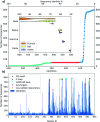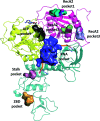Modelling the active SARS-CoV-2 helicase complex as a basis for structure-based inhibitor design
- PMID: 34777769
- PMCID: PMC8528070
- DOI: 10.1039/d1sc02775a
Modelling the active SARS-CoV-2 helicase complex as a basis for structure-based inhibitor design
Abstract
The RNA helicase (non-structural protein 13, NSP13) of SARS-CoV-2 is essential for viral replication, and it is highly conserved among the coronaviridae family, thus a prominent drug target to treat COVID-19. We present here structural models and dynamics of the helicase in complex with its native substrates based on thorough analysis of homologous sequences and existing experimental structures. We performed and analysed microseconds of molecular dynamics (MD) simulations, and our model provides valuable insights to the binding of the ATP and ssRNA at the atomic level. We identify the principal motions characterising the enzyme and highlight the effect of the natural substrates on this dynamics. Furthermore, allosteric binding sites are suggested by our pocket analysis. Our obtained structural and dynamical insights are important for subsequent studies of the catalytic function and for the development of specific inhibitors at our characterised binding pockets for this promising COVID-19 drug target.
This journal is © The Royal Society of Chemistry.
Conflict of interest statement
There are no conflicts to declare.
Figures








Similar articles
-
In Silico Binding of 2-Aminocyclobutanones to SARS-CoV-2 Nsp13 Helicase and Demonstration of Antiviral Activity.Int J Mol Sci. 2023 Mar 7;24(6):5120. doi: 10.3390/ijms24065120. Int J Mol Sci. 2023. PMID: 36982188 Free PMC article.
-
Biochemical analysis of SARS-CoV-2 Nsp13 helicase implicated in COVID-19 and factors that regulate its catalytic functions.J Biol Chem. 2023 Mar;299(3):102980. doi: 10.1016/j.jbc.2023.102980. Epub 2023 Feb 4. J Biol Chem. 2023. PMID: 36739951 Free PMC article.
-
Targeting SARS-CoV-2 nsp13 Helicase and Assessment of Druggability Pockets: Identification of Two Potent Inhibitors by a Multi-Site In Silico Drug Repurposing Approach.Molecules. 2022 Nov 3;27(21):7522. doi: 10.3390/molecules27217522. Molecules. 2022. PMID: 36364347 Free PMC article.
-
Coronaviruses SARS-CoV, MERS-CoV, and SARS-CoV-2 helicase inhibitors: a systematic review of invitro studies.J Virus Erad. 2023 Jun;9(2):100327. doi: 10.1016/j.jve.2023.100327. Epub 2023 May 26. J Virus Erad. 2023. PMID: 37363132 Free PMC article. Review.
-
Current status of antivirals and druggable targets of SARS CoV-2 and other human pathogenic coronaviruses.Drug Resist Updat. 2020 Dec;53:100721. doi: 10.1016/j.drup.2020.100721. Epub 2020 Aug 26. Drug Resist Updat. 2020. PMID: 33132205 Free PMC article. Review.
Cited by
-
Monitoring SARS-CoV-2 Nsp13 helicase binding activity using expanded genetic code techniques.RSC Chem Biol. 2025 Apr 21;6(6):860-868. doi: 10.1039/d4cb00230j. eCollection 2025 Jun 4. RSC Chem Biol. 2025. PMID: 40309067 Free PMC article.
-
Development of Fluorescence-Based Assays for Key Viral Proteins in the SARS-CoV-2 Infection Process and Lifecycle.Int J Mol Sci. 2024 Mar 1;25(5):2850. doi: 10.3390/ijms25052850. Int J Mol Sci. 2024. PMID: 38474097 Free PMC article. Review.
-
Mechanistic insights into bismuth(iii) inhibition of SARS-CoV-2 helicase.Chem Sci. 2024 Jun 3;15(26):10065-10072. doi: 10.1039/d3sc06961c. eCollection 2024 Jul 3. Chem Sci. 2024. PMID: 38966375 Free PMC article.
-
Potential COVID-19 Therapies from Computational Repurposing of Drugs and Natural Products against the SARS-CoV-2 Helicase.Int J Mol Sci. 2022 Jul 12;23(14):7704. doi: 10.3390/ijms23147704. Int J Mol Sci. 2022. PMID: 35887049 Free PMC article.
-
ATPase-dependent duplex nucleic acid unwinding by SARS-CoV-2 nsP13 relies on facile binding and translocation along single-stranded nucleic acid.J Biol Chem. 2025 Jul;301(7):110373. doi: 10.1016/j.jbc.2025.110373. Epub 2025 Jun 12. J Biol Chem. 2025. PMID: 40516869 Free PMC article.
References
-
- Beigel J. H. Tomashek K. M. Dodd L. E. Mehta A. K. Zingman B. S. Kalil A. C. Hohmann E. Chu H. Y. Luetkemeyer A. Kline S. Lopez de Castilla D. Finberg R. W. Dierberg K. Tapson V. Hsieh L. Patterson T. F. Paredes R. Sweeney D. A. Short W. R. Touloumi G. Lye D. C. Ohmagari N. Oh M. Ruiz-Palacios G. M. Benfield T. Fätkenheuer G. Kortepeter M. G. Atmar R. L. Creech C. B. Lundgren J. Babiker A. G. Pett S. Neaton J. D. Burgess T. H. Bonnett T. Green M. Makowski M. Osinusi A. Nayak S. Lane H. C. N. Engl. J. Med. 2020;383:1813–1826. doi: 10.1056/NEJMoa2007764. - DOI - PMC - PubMed
-
- Wang Y. Zhang D. Du G. Du R. Zhao J. Jin Y. Fu S. Gao L. Cheng Z. Lu Q. Hu Y. Luo G. Wang K. Lu Y. Li H. Wang S. Ruan S. Yang C. Mei C. Wang Y. Ding D. Wu F. Tang X. Ye X. Ye Y. Liu B. Yang J. Yin W. Wang A. Fan G. Zhou F. Liu Z. Gu X. Xu J. Shang L. Zhang Y. Cao L. Guo T. Wan Y. Qin H. Jiang Y. Jaki T. Hayden F. G. Horby P. W. Cao B. Wang C. Lancet. 2020;395:1569–1578. doi: 10.1016/S0140-6736(20)31022-9. - DOI - PMC - PubMed
LinkOut - more resources
Full Text Sources
Miscellaneous

